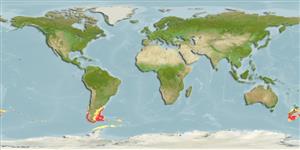Classification / Names
Common names from other countries
Main reference
Size / Weight / Age
Max length : 90.0 cm TL male/unsexed; (Ref. 1371); common length : 60.0 cm TL male/unsexed; (Ref. 1371); max. published weight: 850.00 g (Ref. 4883)
Length at first maturity
Lm ?, range 33 - 40 cm
Environment
Marine; benthopelagic; oceanodromous (Ref. 51243); depth range 50 - 900 m (Ref. 27363), usually 200 - 400 m (Ref. 7061)
Climate / Range
Temperate, preferred 9°C (Ref. 107945); 37°S - 65°S, 165°E - 34°W (Ref. 54589)
Distribution
There are 2 disjunct populations. Micromesistius australis australis occurs around the Falkland Islands and Argentine Patagonia in the southwest Atlantic; off Chile in the southeast Pacific; also off South Georgia, South Shetland and South Orkney islands. Micromesistius australis pallidus occurs around the South Island of New Zealand.
Countries | FAO areas | Ecosystems | Occurrences | Introductions
Short description
IUCN Red List Status (Ref. 115185)
Threat to humans
Harmless
Human uses
Fisheries: highly commercial
Tools
Special reports
Download XML
Internet sources
Estimates of some properties based on models
Phylogenetic diversity index
PD50 = 0.7500 many relatives (e.g. carps) 0.5 - 2.0 few relatives (e.g. lungfishes)
Trophic Level
3.3 ±0.48 se; Based on food items.
Resilience
Medium, minimum population doubling time 1.4 - 4.4 years (K=0.18; tm=2-5; tmax=30)
Vulnerability
Moderate to high vulnerability (52 of 100)
Price category
